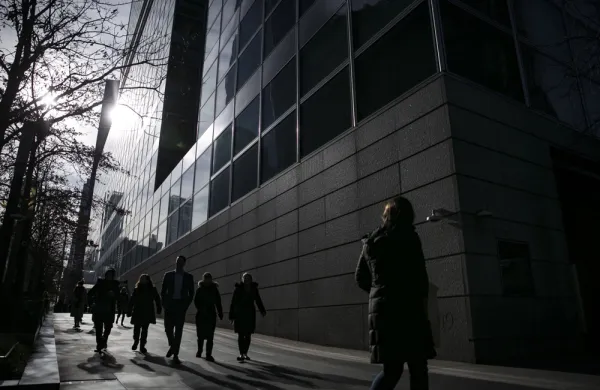Emerging-markets stocks have taken a beating in recent years, depressed by the continuing slump in commodities prices and slowing growth, especially in China. But some investors see attractive value in one intriguing corner of this sector: the shares of emerging markets’ stock exchanges themselves.
It may seem counterintuitive to invest in the sites where the carnage is taking place. Emerging-markets equities have been in a bear market for five years, and the sell-off accelerated last year with the benchmark MSCI Emerging Markets index falling nearly 17 percent in 2015. Yet the exchanges offer value that many other EM stocks do not.
For starters, they are natural monopolies. Light on capital requirements, they generate lots of cash flow and often pay high dividend yields. And exchanges can perform well even in bear markets, if trading volumes remain strong. “We love stock exchanges,” says Kathryn Koch, global head of client portfolio management and business strategy, fundamental equity, at Goldman Sachs Asset Management in London. “We can’t get enough of them.”
Investors in EM stock exchanges differ in their perspectives: Some buy and hold, whereas others get in only when the valuation is compelling and leave after share prices rise to an expected target value.
Standard Life Investments takes a tactical approach. “For us, if a stock exchange is priced appropriately for the merits of its business model, then it’s not necessarily that interesting an investment,” says Mark Vincent, investment director of emerging-markets equities at the Edinburgh-based investment firm. “It becomes interesting when there is a dynamic of change that is going to drive earnings and cash flow above market expectations.”
Such dynamics may include the advent of high frequency trading, increased market volatility, growth in derivatives products and the rise of multiasset funds. “All those things bring more trading volume to an exchange,” says Vincent. “That drives up revenue.” For example, at BM&F Bovespa in Brazil, the average daily trading volume in the third quarter of 2015 was up 24 percent over the year-earlier period, even though the Brazilian economy sank deeper into recession.
Standard Life’s Global Emerging Markets Equity Income Strategy, which was launched in June 2012 and has £321.5 million ($468.2 million) in assets, invested in the São Paulo–based exchange at a time when market fears about the possible launch of a rival exchange drove down BM&F Bovespa’s share price, according to Vincent. “We thought those fears were overblown,” he says. The exchange’s shares rose 43 percent from June 2012 to January 28, 2013, whereas the benchmark Ibovespa index declined 22 percent over that period.
Standard Life also invested in the Moscow Exchange’s February 2013 initial public offering. “The Moscow Exchange was getting quite a lot of local listings and looking to bring some of the liquidity from London back onto the exchange in Moscow,” which made the exchange an attractive investment, Vincent says. In the five years ended January 7, the MICEX index has risen a paltry 1 percent, whereas shares in the Moscow Exchange Group have soared 73.3 percent.
Standard Life has since exited both the Moscow and São Paulo exchange holdings, although Vincent did not provide details of the date or performance of those investments.
Goldman Sachs Asset Management pursues more of a buy-and-hold strategy. “Our philosophy is to find outsized returns over time in sound, strong businesses at a big discount to intrinsic value,” Koch says. The company’s $5 billion emerging-markets funds have as much as 10 percent exposure to stock exchanges and currently hold stakes in exchanges in Brazil, Mexico, Poland, South Africa and Hong Kong. By comparison, exchanges make up just 1.5 percent of the MSCI Emerging Markets index.
Goldman likes the fact that trading volumes on stock exchanges can be high when markets are going down as well as up. “It’s not necessarily a pro-cyclical game,” says Koch. “It’s a company that’s tied to flows — and flows can be strong throughout the cycle.”
BM&F Bovespa, one of Goldman’s holdings, illustrates the staying power for stock exchanges in down markets. As Brazil’s commodity-driven boom has gone bust, the benchmark Ibovespa stock index fell 13.3 percent in 2015, but shares of BM&F Bovespa rose 11.5 percent for the year. Part of the São Paulo stock exchange’s appeal is its track record of strong trading volume.
South Africa is another emerging-markets economy hit by the crash in commodity prices. The country narrowly avoided recession in 2015 as gross domestic product declined at a 1.3 percent rate in the second quarter but rebounded at a 0.7 percent rate in the third. Even so, shares in JSE, the company that runs the Johannesburg Stock Exchange, rose by 7.9 percent in 2015. Over the past two years, JSE shares have soared some 50 percent. In Johannesburg, as in São Paulo, high trading volumes and the accompanying profits — even during the downside of the business cycle — have helped the exchanges shares outperform the broader market.
Goldman especially likes the fact that dividend yields on stock exchanges can be sky-high. For example, the WSE Group, which runs the Warsaw Stock Exchange in Poland, decided to boost its dividend yield. “Last year we paid out 89.9 percent of our profit in dividends,” says Grzegorz Zawada, chief strategy officer and vice president of the management board at the Warsaw Stock Exchange. Even so, WSE Group’s share price, which zoomed ahead earlier in the year in response to the dividend boost, reversed course and ended the year with a decline of 21 percent.
Not all of Goldman’s stock exchange investments have seen big gains. The Bolsa Mexicana de Valores suffered a 13.6 percent share price decline in 2015 — not quite as bad as the nearly 17 percent fall in the overall MSCI emerging-markets benchmark. One reason is the breadth of trading on the exchange. “Unlike exchanges in places like New York or São Paulo, our exchange generates a lot of revenue from the debt market,” maintains José Manuel Allende, senior vice president of issuers and information services at Bolsa Mexicana.
Overall, though, given their very nature as emerging markets — that is, economies with plenty of room for development — Goldman sees long-term potential for these countries’ stock exchanges. “As capital formation takes place, more of the market capitalization will be listed, and exchanges will be the beneficiaries of that,” Koch says.
Get more on emerging markets.






